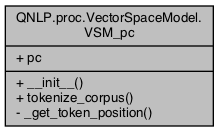QNLP.proc.VectorSpaceModel.VSM_pc Class Reference
Collaboration diagram for QNLP.proc.VectorSpaceModel.VSM_pc:

Public Member Functions | |
| def | __init__ (self) |
| def | tokenize_corpus (self, corpus, proc_mode=0, stop_words=True, use_spacy=False) |
Data Fields | |
| pc | |
Private Member Functions | |
| def | _get_token_position (self, tagged_tokens, token_type) |
Detailed Description
Definition at line 27 of file VectorSpaceModel.py.
Constructor & Destructor Documentation
◆ __init__()
| def QNLP.proc.VectorSpaceModel.VSM_pc.__init__ | ( | self | ) |
Definition at line 28 of file VectorSpaceModel.py.
Member Function Documentation
◆ _get_token_position()
|
private |
Tracks the positions where a tagged element is found in the tokenised corpus list. Useful for comparing distances. If the key doesn't initially exist, it adds a list with a single element. Otherwise, extends the list with the new token position value.
Definition at line 89 of file VectorSpaceModel.py.
Referenced by QNLP.proc.VectorSpaceModel.VSM_pc.tokenize_corpus().
Here is the caller graph for this function:

◆ tokenize_corpus()
| def QNLP.proc.VectorSpaceModel.VSM_pc.tokenize_corpus | ( | self, | |
| corpus, | |||
proc_mode = 0, |
|||
stop_words = True, |
|||
use_spacy = False |
|||
| ) |
Rewrite of pc.tokenize_corpus to allow for tracking of basis word positions in list to improve later pairwise distance calculations.
Definition at line 31 of file VectorSpaceModel.py.
64 #spacy_pos_tagger = 2000000 #Uses approx 1GB memory for each 100k tokens; assumes large memory pool
87 return {'verbs':count_verbs, 'nouns':count_nouns, 'tk_sentence':token_sents, 'tk_words':token_words}
def remove_stopwords(text, sw)
Definition: process_corpus.py:19
def tokenize_corpus(corpus, proc_mode=0, stop_words=True)
Definition: process_corpus.py:25
References QNLP.proc.VectorSpaceModel.VSM_pc._get_token_position(), QNLP.proc.VectorSpaceModel.VSM_pc.pc, and QNLP.proc.process_corpus.remove_stopwords().
Here is the call graph for this function:

Field Documentation
◆ pc
| QNLP.proc.VectorSpaceModel.VSM_pc.pc |
Definition at line 29 of file VectorSpaceModel.py.
Referenced by QNLP.proc.VectorSpaceModel.VectorSpaceModel.load_tokens(), and QNLP.proc.VectorSpaceModel.VSM_pc.tokenize_corpus().
The documentation for this class was generated from the following file:
- /Users/mlxd/Desktop/intel-qnlp-rc2/modules/py/pkgs/QNLP/proc/VectorSpaceModel.py
